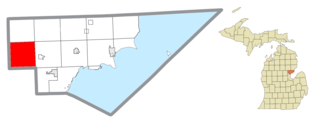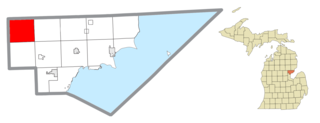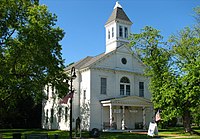
Arenac County is a county located in the U.S. state of Michigan. As of the 2020 Census, the population was 15,002. The county seat is Standish.

Adams Township is a civil township of Arenac County in the U.S. state of Michigan. As of the 2010 census, the township population was 563.

Arenac Township is a civil township of Arenac County in the U.S. state of Michigan. As of the 2010 census, the township population was 903. The city of Omer is surrounded by the township but is administered autonomously.

Au Gres is a city in Arenac County in the U.S. state of Michigan. The population was 889 at the 2010 census.

Au Gres Township is a civil township of Arenac County in the U.S. state of Michigan. As of the 2010 census, the township population was 953. The city of Au Gres borders the township to the east but both are administered autonomously.

Clayton Township is a civil township of Arenac County in the U.S. state of Michigan. The population was 1,097 at the 2010 census.

Deep River Township is a civil township of Arenac County in the U.S. state of Michigan. The population was 2,149 at the 2010 census. The village of Sterling is located within the township.

Lincoln Township is a civil township of Arenac County in the U.S. state of Michigan. The population was 942 at the 2010 census. The city of Standish borders the township on the northeast but is administered autonomously.

Mason Township is a civil township of Arenac County in the U.S. state of Michigan. The population was 851 at the 2010 census. The western portion of the village of Twining is located within the township.

Moffatt Township is a civil township of Arenac County in the U.S. state of Michigan. The population was 1,184 at the 2010 census.

Sims Township is a civil township of Arenac County in the U.S. state of Michigan. The population was 1,095 at the 2010 census.

Standish is a city in the U.S. state of Michigan. The population was 1,458 at the 2020 census. It is the county seat of Arenac County.

Standish Township is a civil township of Arenac County in the U.S. state of Michigan. The population was 1,900 at the 2010 census. The city of Standish borders the township on the northwest but is administered autonomously.

Turner Township is a civil township of Arenac County in the U.S. state of Michigan. As of the 2010 census, it had a population of 550. The villages of Turner and the eastern portion of Twining are located within the township.

Whitney Township is a civil township of Arenac County in the U.S. state of Michigan. The population was 1,001 at the 2010 census.
Sherman Township is a civil township of Iosco County in the U.S. state of Michigan. The population was 493 at the 2000 census and slightly decreased to 448 at the 2010 census.
Whittemore is a city in Iosco County in the U.S. state of Michigan. The population was 414 at the 2020 census, which ranks it as the fourth-least populated city in the state after Omer, Lake Angelus, and Gaastra.

Churchill Township is a civil township of Ogemaw County in the U.S. state of Michigan. The population was 1,713 at the 2010 census.

Zilwaukee is a city in Saginaw County in the U.S. state of Michigan. The 2010 census places the population at 1,658. The city is adjacent to and was created from Zilwaukee Township. It is the home of the Zilwaukee Bridge.

Woodhaven is a city in Wayne County in the U.S. state of Michigan. As of the 2010 census, the city had a population of 12,875. It is part of a collection of communities known as Downriver.























